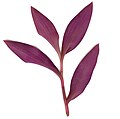You are here
Monocotyledons / Monocotiledóneas
Tradescantia pallida (Rose) D.R.Hunt
EOL Text
Isotype for Setcreasea lanceolata Faruqi et al.
Catalog Number: US 470996
Collection: Smithsonian Institution, National Museum of Natural History, Department of Botany
Verification Degree: Original publication and alleged type specimen examined
Preparation: Pressed specimen
Collector(s): E. Palmer
Year Collected: 1904
Locality: San Dieguito., San Luis Potosí, Mexico, North America
- Isotype: Faruqi, S. A., et al. 1962. Rhodora. 64: 330.
| License | http://creativecommons.org/licenses/by/3.0/ |
| Rights holder/Author | This image was obtained from the Smithsonian Institution. Unless otherwise noted, this image or its contents may be protected by international copyright laws. |
| Source | http://collections.mnh.si.edu/search/botany/?irn=2548429 |
Isotype for Setcreasea lanceolata Faruqi et al.
Catalog Number: US 470997
Collection: Smithsonian Institution, National Museum of Natural History, Department of Botany
Verification Degree: Original publication and alleged type specimen examined
Preparation: Pressed specimen
Collector(s): E. Palmer
Year Collected: 1904
Locality: San Luis Potosi, Mexico, North America
- Isotype: Faruqi, S. A., et al. 1962. Rhodora. 64: 330.
| License | http://creativecommons.org/licenses/by/3.0/ |
| Rights holder/Author | This image was obtained from the Smithsonian Institution. Unless otherwise noted, this image or its contents may be protected by international copyright laws. |
| Source | http://collections.mnh.si.edu/search/botany/?irn=2089021 |
Holotype for Setcreasea pallida Rose
Catalog Number: US 572818
Collection: Smithsonian Institution, National Museum of Natural History, Department of Botany
Verification Degree: Original publication and alleged type specimen examined
Preparation: Pressed specimen
Collector(s): E. Palmer
Year Collected: 1907
Locality: Near Victoria., Tamaulipas, Mexico, North America
- Holotype: Rose, J. N. 1911. Contr. U.S. Natl. Herb. 13: 294.
| License | http://creativecommons.org/licenses/by/3.0/ |
| Rights holder/Author | This image was obtained from the Smithsonian Institution. Unless otherwise noted, this image or its contents may be protected by international copyright laws. |
| Source | http://collections.mnh.si.edu/search/botany/?irn=2110567 |
Flowering summer--fall. Landfill and old home sites; introduced; Fla., La.; native, Mexico.
| License | http://creativecommons.org/licenses/by-nc-sa/3.0/ |
| Rights holder/Author | eFloras.org Copyright © Missouri Botanical Garden |
| Source | http://www.efloras.org/florataxon.aspx?flora_id=1&taxon_id=222000427 |
Barcode of Life Data Systems (BOLDS) Stats
Public Records: 2
Specimens with Barcodes: 2
Species With Barcodes: 1
United States
Rounded National Status Rank: NNA - Not Applicable
| License | http://creativecommons.org/licenses/by-nc/3.0/ |
| Rights holder/Author | NatureServe |
| Source | http://explorer.natureserve.org/servlet/NatureServe?searchName=Tradescantia+pallida |
Rounded Global Status Rank: GNR - Not Yet Ranked
| License | http://creativecommons.org/licenses/by-nc/3.0/ |
| Rights holder/Author | NatureServe |
| Source | http://explorer.natureserve.org/servlet/NatureServe?searchName=Tradescantia+pallida |
Tradescantia pallida is a species of spiderwort (a genus of New World plants) more commonly known as wandering jew, a name it shares with the closely related species T. fluminensis and T. zebrina. Other common names include purple secretia, purple-heart[2] and purple queen. It is native to the Gulf Coast region of eastern Mexico. Edward Palmer was the first European to observe and assign a Latin name to the type specimen near Ciudad Victoria, Tamaulipas in 1907.[3]
Description[edit]
T. pallida is an evergreen perennial plant of scrambling stature. It is distinguished by elongated, pointed leaves - themselves glaucous green, fringed with red or purple - and bearing small, sterile three-petaled flowers of white, pink or purple. Plants are top-killed by moderate frosts, but will often sprout back from roots.[4] Protection by mulching will increase the chances of sprouting in marginal areas.
Cultivation[edit]
Widely used as an ornamental plant in gardens and borders, as a ground cover, hanging plant, or - particularly in colder climates where it cannot survive the winter season - houseplant, it is propagated easily by cuttings (the stems are visibly segmented and roots will frequently grow from the joints). However, this very characteristic, in addition to the fact that it is remarkably shade-tolerant and can thrive in a wide range of soil conditions, makes T. pallida quite formidable should it be encountered in situations where it has not been intentionally cultivated and carefully maintained. In areas throughout the southern United States and Australia, it is considered an invasive species and has defied many attempts at control or eradication.
As a houseplant, T. pallida has been judged exceptionally effective at improving indoor air quality by filtering out volatile organic compounds, a class of common pollutants and respiratory irritants, via a process known as phytoremediation.[5]
Numerous cultivars are available, of which 'Purpurea' with purple foliage has gained the Royal Horticultural Society's Award of Garden Merit.[6]
Nomenclature[edit]
There is some controversy regarding the correct scientific name for this species, with certain authorities continuing to refer to it as Setcreasea purpurea or Setcreasea pallida. The comparatively more recent denomination Tradescantia pallida appears to enjoy greater acceptance and wider usage at present.
References[edit]
- ^ "Taxon: Tradescantia pallida (Rose) D. R. Hunt". Germplasm Resources Information Network. United States Department of Agriculture. 1997-05-02. Retrieved 2011-11-20.
- ^ "BSBI List 2007" (xls). Botanical Society of Britain and Ireland. Archived from the original on 2015-02-25. Retrieved 2014-10-17.
- ^ "Search the Botany Collections". United States National Herbarium. Smithsonian Museum of Natural History. Retrieved 2011-11-20.
- ^ Duever, Linda Conway (2006-08-31). "#734 Tradescantia pallida". Floridata.
- ^ Yang, Dong Sik, Pennisi, Svoboda V., Son, Ki-Cheol, Kays, Stanley J. Screening Indoor Plants for Volatile Organic Pollutant Removal Efficiency. HortScience, Published online 1 August 2009; in print 44: 1377-1381 (2009)
- ^ "RHS Plant Selector - Tradescantia pallida". Retrieved 5 July 2013.
| License | http://creativecommons.org/licenses/by-sa/3.0/ |
| Rights holder/Author | Wikipedia |
| Source | http://en.wikipedia.org/w/index.php?title=Tradescantia_pallida&oldid=648228314 |
Distribution: Native of Central America and Southern U.S., widely cultivated as an ornamental in tropical and subtropical regions.
| License | http://creativecommons.org/licenses/by-nc-sa/3.0/ |
| Rights holder/Author | eFloras.org Copyright © Missouri Botanical Garden |
| Source | http://www.efloras.org/florataxon.aspx?flora_id=5&taxon_id=242414348 |




